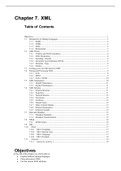Class notes
Web Programming/Development Course Notes
- Course
- CPRG 213A
- Institution
- Southern Alberta Institute Of Technology (SAIT )
Are you looking to learn web development but don't know where to start? Do you struggle to keep track of all the different languages, frameworks, and tools that are used in web development? Look no further! Our web development notes have got you covered. Our comprehensive notes cover all the ess...
[Show more]



